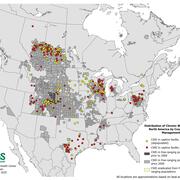Advancing the Use of RT-QuIC for Applications in CWD Management
Chronic wasting disease (CWD) is an emerging infectious disease that is fatal to free-ranging and captive animals in Cervidae, the deer family. The development of the real-time quaking-induced conversion (RT-QuIC) assay has the potential to transform laboratory research of prions and provide new opportunities for improved surveillance and management.

However, the widespread application of RT-QuIC has been hampered by 1) the lack of well-characterized reference samples to ensure proper assay functioning, identify optimal tissues for ante-mortem sampling, and determine biological relevance of results and 2) the absence of an appropriate modeling framework to leverage the information produced by RT-QuIC. In collaboration with the University of Wisconsin, state and federal partners, the USGS National Wildlife Health Center (NWHC) is working to fill these gaps by using RT-QuIC to fully characterize a range of biological tissues, body fluids, and excreta that are CWD-positive and -negative and comparing those results against the gold standard animal bioassay (a transgenic mouse bioassay). NWHC is also building a modeling framework that will help managers determine appropriate control strategies by assessing the relative importance of environmental transmission, as measured by RT-QuIC, in CWD dynamics. The availability of reference samples and a robust modeling framework for CWD diagnostic labs and managers will help promote the rigorous application of RT-QuIC, identify optimal tissues for ante-mortem sampling, assess biological relevancy of findings, and provide a mechanism to leverage RT-QuIC information to aid CWD control efforts.
Below are other science projects associated with this project.
Assessing the Ability of Incineration to Inactivate CWD Prions from Carcasses
Application of a systems approach for management of chronic wasting disease
Expanding Distribution of Chronic Wasting Disease
Enhanced Capacity for Chronic Wasting Disease Research and Certified Diagnostics at the USGS National Wildlife Health Center
Chronic Wasting Disease
Below are partners associated with this project.
Chronic wasting disease (CWD) is an emerging infectious disease that is fatal to free-ranging and captive animals in Cervidae, the deer family. The development of the real-time quaking-induced conversion (RT-QuIC) assay has the potential to transform laboratory research of prions and provide new opportunities for improved surveillance and management.

However, the widespread application of RT-QuIC has been hampered by 1) the lack of well-characterized reference samples to ensure proper assay functioning, identify optimal tissues for ante-mortem sampling, and determine biological relevance of results and 2) the absence of an appropriate modeling framework to leverage the information produced by RT-QuIC. In collaboration with the University of Wisconsin, state and federal partners, the USGS National Wildlife Health Center (NWHC) is working to fill these gaps by using RT-QuIC to fully characterize a range of biological tissues, body fluids, and excreta that are CWD-positive and -negative and comparing those results against the gold standard animal bioassay (a transgenic mouse bioassay). NWHC is also building a modeling framework that will help managers determine appropriate control strategies by assessing the relative importance of environmental transmission, as measured by RT-QuIC, in CWD dynamics. The availability of reference samples and a robust modeling framework for CWD diagnostic labs and managers will help promote the rigorous application of RT-QuIC, identify optimal tissues for ante-mortem sampling, assess biological relevancy of findings, and provide a mechanism to leverage RT-QuIC information to aid CWD control efforts.
Below are other science projects associated with this project.
Assessing the Ability of Incineration to Inactivate CWD Prions from Carcasses
Application of a systems approach for management of chronic wasting disease
Expanding Distribution of Chronic Wasting Disease
Enhanced Capacity for Chronic Wasting Disease Research and Certified Diagnostics at the USGS National Wildlife Health Center
Chronic Wasting Disease
Below are partners associated with this project.






